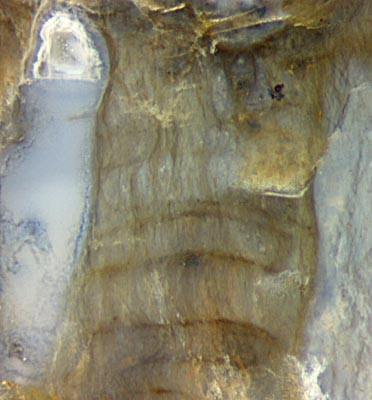Swamp gas bubbles traversing microbial
layers in Rhynie chert

The Lower Devonian Rhynie chert is known mainly for its fossil plants
and creatures but it may also reveal
ample information on the succession of processes which had been going
on before and
during silicification.
Fig.1: Rhynie chert, bubbles
forcing their way through microbial layers before or during
silicification. Width of the image 10mm.
Most conspicuous in Fig.1 is the former cavity filled with chalzedony
levels and quartz above. The level fills were deposited when emulsions had
formed in the water-filled cavity. The the black deposit with its slightly wavy surface poses a problem which will not be considered here. As one may guess,
the now filled cavities once had been gas
bubbles in water.
Above and below
the watery stratum with the
broad bubbles there are layer
stacks of another type: nearly horizontal, doubtless of microbial
origin, continuous and locally eroded above
but penetrated by tube-like cavities below. It is not known whether or in which way
their formation is related to
the upright growth of microbial filaments of a
few Ám thickness, seen in Fig.2 when in bunches. The similarity to the filaments
of the cyanobacterium Croftalania venusta,
whose
prolific stands are there in the same chert sample, had been noticed
before by [1] in connection with a sample apparently quite
similar to this one [2].

Fig.2: Filamentous cyanobacteria grown upright through formerly
horizontal layers, the latter sagging beside bubble pathways
right
and left.
Width of the image 1.8mm.
Fig.1 suggests that gas generated below had forced
its way through
the stack of microbial layers until it ended up in the watery stratum
above where it accumulated into
wider bubbles which got stuck there.
The previously horizontal layering is seen deformed
near the vertical tubes left in the wake of ascending bubbles. Here,
surprisingly, an
apparent paradox arises: The ascending bubble should have pushed up
part of every layer while forcing its way
through. Hence, one expects to see some
residual upward bend of the layers at the tubes but the bend is
downward.
The
essential part of this unexpected phenomenon may become comprehensible
by means of
a thought experiment: Imagine a horizontal surface of a material with
extremely low elastic modulus, like gel prepared with gelatine and much
water. Let a vertical cylinder
be cut out. This takes the pressure away from the
cylindrical cavity wall
whereby the gel shifts
inward and downward under its own weight until
the mechanical
equilibrium is restored:
If initially it were marked by
straight lines, one would see them sagging near the cavity,
similar
as in Fig.1.
The less easily imaginable first part of the phenomenon,
performed by the ascending bubble making a tube-like cavity into a
material with obscure rheological properties, has not been considered
here.
Any attempted explanation of what
was going on at
the earliest stages of the solidification which finally produced the
Rhynie chert should
take into account that
the material properties of complex systems like this one, with densely
spaced aligned filaments more or less coated with organic or inorganic
gel,
floating in water or partially sticking to each other, are expected to
deviate from those of common liquids and solids.
H.-J. Weiss
2015
[1] M. Krings, H. Kerp, H. Hass, T.N.
Taylor, N.
Dotzler:
A filamentous
cyanobacterium showing structured colonial growth from the Early
Devonian Rhynie chert.
Rev. Palaeobot. Palyn.
146(2007), 265-276.
[2] H.-J. Weiss:
Croftalania venusta
and other Lower Devonian microbes. Rhynie Chert
News 56
 |
 |
80 |





